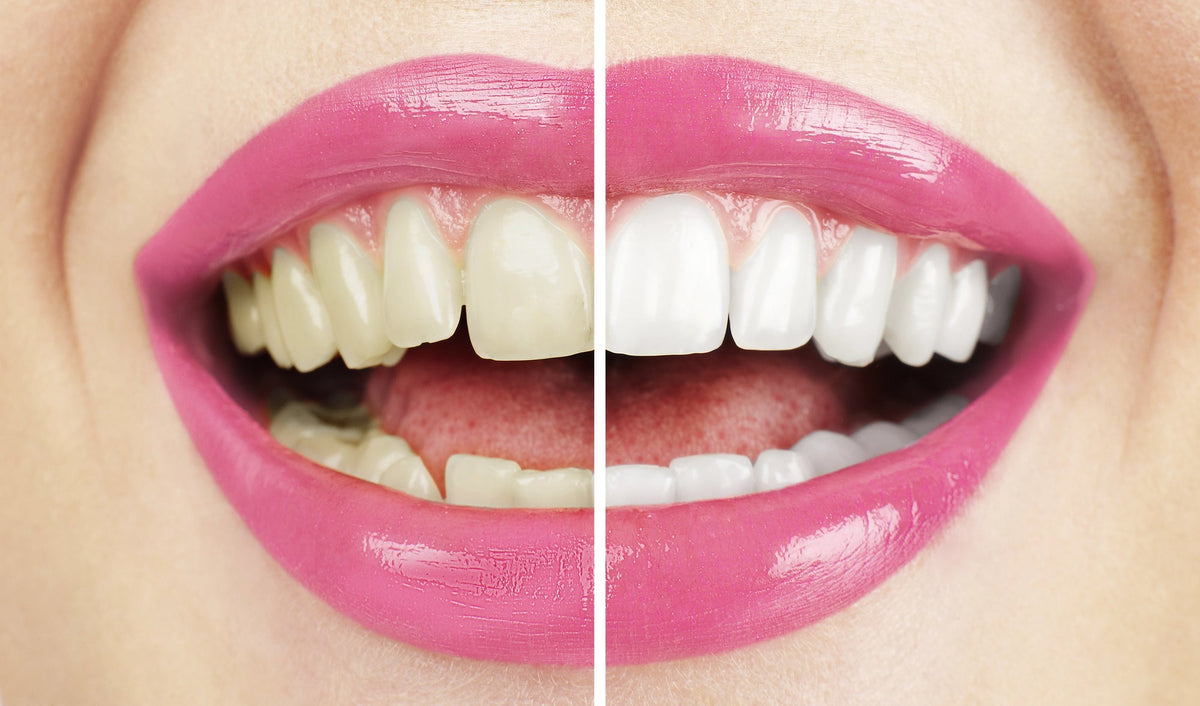
The Truth About Whitening: Does It Damage Your Teeth?
|
Time to read 5 min
|
Time to read 5 min
Teeth whitening is one of the most sought-after cosmetic dental treatments today. From over-the-counter whitening strips to in-office bleaching procedures, the market is full of promises to help you achieve a brighter, whiter smile. But many people are left wondering—is teeth whitening actually safe? Does it damage your enamel? And what are the best alternatives for long-term oral health?
In this blog, we’ll break down the science behind common whitening methods, debunk widespread myths, and introduce a naturally safe and effective alternative: nano-hydroxyapatite (nHA). Understanding what’s really happening to your teeth during whitening will help you make informed choices that protect both your smile and your health.
Before we dive into whitening treatments, it’s important to understand what makes teeth appear discolored in the first place. There are two primary types of tooth discoloration:
The effectiveness of whitening treatments depends on the type and severity of the stain, but so does the potential for enamel damage.
The Most Common Whitening Methods (and How They Work)
1. Hydrogen Peroxide and Carbamide Peroxide Whitening
Most professional and at-home whitening systems use hydrogen peroxide or carbamide peroxide as the active ingredient. These chemicals work by breaking down stain molecules on and within the enamel, making teeth appear whiter. While these ingredients are effective, they are not without drawbacks.
The concerns:
2. Whitening Toothpastes and Abrasives
Some toothpastes claim to “whiten” by physically scrubbing away stains using abrasive particles. While this can reduce surface stains, high-abrasion pastes may also wear down enamel, especially if used daily or with hard brushing.
3. LED Whitening Kits
LED lights are sometimes marketed as enhancing the whitening process, but the light itself doesn’t whiten teeth. It simply activates or accelerates the peroxide reaction. The real whitening still comes from the chemical agents used.
Whitening Myths: What’s True and What’s Not?
Myth #1: All teeth whitening damages enamel.
False. Not all whitening methods are harmful, especially when used under guidance and with safe concentrations. However, excessive or improper use—especially with strong over-the-counter kits—can lead to enamel erosion and sensitivity.
Myth #2: Whitening works the same for everyone.
False. Results vary based on the type of staining, enamel thickness, and individual oral chemistry. Intrinsic stains, for example, are harder to treat and may not respond well to peroxide-based whiteners.
Myth #3: You can whiten your teeth naturally with lemon juice or baking soda.
Dangerous. These DIY methods are acidic or abrasive and can severely erode enamel over time, leading to increased sensitivity and yellowing (from thinning enamel revealing more dentin underneath).
So, Is Teeth Whitening Safe?
When done properly, whitening can be safe—but it’s not without risks. Supervised treatments with lower concentrations and built-in enamel protection are safer than high-strength, unregulated kits. Still, even dentist-approved methods don’t actually restore enamel or remineralize teeth. They remove stains, but don’t rebuild or protect.
That’s where nano-hydroxyapatite (nHA) comes in.
Enter Nano-Hydroxyapatite: Naturally Whitening and Enamel Safe
Nano-hydroxyapatite is a biocompatible, non-toxic material that mimics the natural structure of tooth enamel. Originally developed by NASA to help astronauts combat mineral loss in zero gravity, it has since become a leading innovation in oral care. Unlike peroxide-based whiteners that bleach stains, nHA works by rebuilding and strengthening enamel, which in turn creates a smoother, whiter, healthier-looking surface.
Here’s how it works:
Why nHA Is a Whitening Game-Changer
Traditional whitening products treat the symptom—stains—but not the root cause, which is often weakened or porous enamel. Nano-hydroxyapatite addresses the structural health of the tooth, making your smile stronger and brighter over time.
Several studies have shown that nHA is just as effective (if not more so) than fluoride in preventing cavities, and it adds cosmetic benefits without risk. Many remineralizing toothpastes now include nHA as a star ingredient—and some users report noticeable whitening within weeks of consistent use.
It’s important to note that while nano-hydroxyapatite (nHA) offers many incredible benefits for enamel health and natural whitening, it doesn’t work in the same way as peroxide-based whitening treatments. nHA helps gradually brighten teeth by filling in microscopic cracks and rebuilding the enamel surface, which reflects light better and creates a smoother, whiter appearance. However, this type of whitening is subtle — typically raising the tooth color a few shades, but not producing the dramatic, instant results that peroxide bleaching can achieve. That said, nano-hydroxyapatite shines when it comes to protecting and repairing your teeth, especially after peroxide-based whitening. It helps remineralize weakened and damaged enamel, restoring strength, reducing sensitivity, and supporting long-term enamel health following chemical whitening treatments.
How to Safely Whiten Your Teeth Without Damage
If you’re looking for a whiter smile without compromising your enamel, here are some safe, science-backed tips:
So, does teeth whitening damage your teeth? It can—if done excessively or incorrectly. High-strength peroxide treatments and abrasive toothpastes can erode enamel and lead to long-term sensitivity and damage. But safe, supervised treatments used sparingly, or better yet, switching to nano-hydroxyapatite-based products, offer a safe, effective, and natural path to a brighter smile.
Nano-hydroxyapatite isn’t just the future of tooth care—it’s a proven, science-backed solution that supports both the cosmetic and functional health of your teeth. For those seeking a radiant smile without the trade-offs of traditional whitening, nHA is the smart, enamel-friendly choice.
Yes, if you address the root cause early, sensitivity can improve with proper care.
Absolutely! Ingredients like hydroxyapatite and calcium phosphate can rebuild enamel naturally without fluoride.


